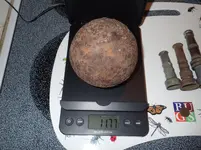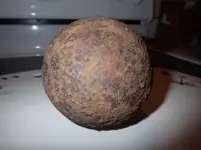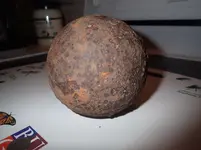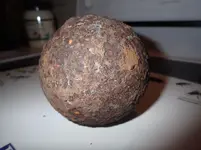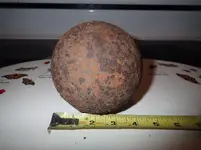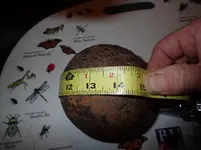The good news is, at this point it does look like a 150-300 year old excavated cannonball ought to look. It appears to be a True Sphere (not out of round, lumpy, etc). Also, the rust-crust is right for cast-iron (rust-crust on steel looks different... and there were no steel cannonballs except for British 10-inch anti-ironclad balls in the 1860s).
I'm looking forward to seeing what it looks like after cleaning.

Hopefully you can get its diameter measured with something better than a steel tape. For the moment, taking into account the difficulty of bending the end of the steel tape close enough to the ball, and the thickness of the rust-crust is included in the measurement... circumference of "about" 14.5-inches, divided by Pi (3.1416) equals about 4.61-inches in diameter. Subtracting the rust-crust thickness, your ball is right in the correct range for a Revolutionary War (or perhaps earlier, like French-&-Indian War) 12-Pounder cannonball... approximately 4.45-inches in diameter). Let's try measuring it again after Electrolysis has removed the rust-crust.
I should also mention.... it's a little lightweight for a 12-Pounder Solid Shot, but RevWar cannonballs are notorious for containing a lot of internal "casting flaw" airbubbles, due to poor-quality ironcasting at that time in the history of metalcasting. The internal airbubbles cause the ball to be lighter than it's diameter would indicate it should weigh.
Here's a link to an Educational article I co-wrote, with instructions for how to correctly determine whether a ball is a cannonball or not:
http://www.pochefamily.org/books/SolidShotEssentialsMod.html